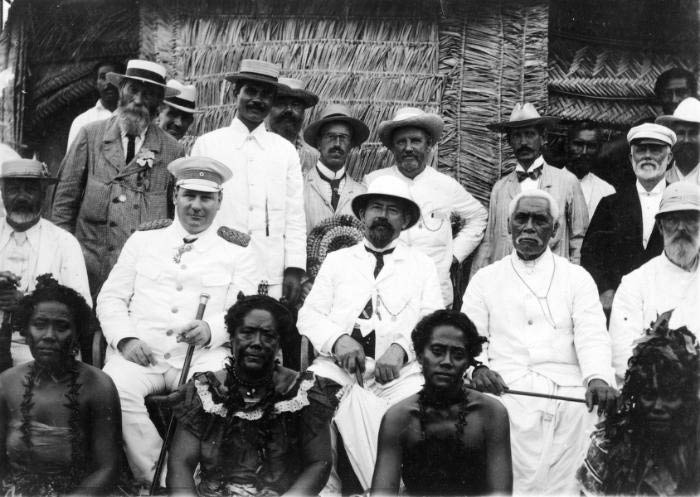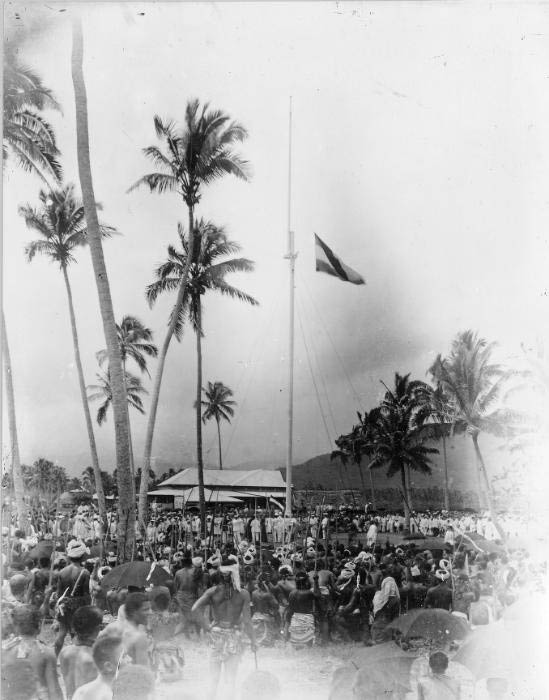 German Samoa was a short-lived protectorate of the German Empire, lasting from 1900 until 1914. It consisted of four islands: Manono, Apolima, Savai’i, and Upolu, all of which are now part of the independent republic of Samoa. Unusually for a German Pacific possession, Samoa was not administered as part of German New Guinea. The territory was initially granted to Germany under the Tripartite Convention of 1899, and it was the last new German colony in the Pacific.
German Samoa was a short-lived protectorate of the German Empire, lasting from 1900 until 1914. It consisted of four islands: Manono, Apolima, Savai’i, and Upolu, all of which are now part of the independent republic of Samoa. Unusually for a German Pacific possession, Samoa was not administered as part of German New Guinea. The territory was initially granted to Germany under the Tripartite Convention of 1899, and it was the last new German colony in the Pacific.
Background of German Samoa
In the latter part of the 19th century, German influence on Samoa increased considerably as a result of plantation activity. The most important crops were rubber, cacao, and coconut, while German companies also controlled most of the copra processing businesses.
Tensions rose as a result of the differing interests of these German firms and various American and British business interests. This culminated in the first Samoan Civil War, which was fought around 1890. Most of the combatants were Samoans, although Germany occasionally intervened – something opposed by the United States and Britain.
Dividing Samoa
 After a second civil war in the late 1890s, the three powers agreed to divide Samoa between them. Germany was allocated those islands which stood to the west of the 171 degree line. Now that the German hold over the western islands was secure and universally accepted, the country further increased its plantation operations.
After a second civil war in the late 1890s, the three powers agreed to divide Samoa between them. Germany was allocated those islands which stood to the west of the 171 degree line. Now that the German hold over the western islands was secure and universally accepted, the country further increased its plantation operations.
The largest companies not only operated enormous agricultural concerns, but they also ran fleets of ships and imported Chinese and Melanesian workers for the farms. Around 2,000 Chinese workers were present in Samoa by 1914.
Administration of Samoa
Wilhelm Solf, the first governor of the new colony, proved himself to be a thoughtful and careful administrator. He incorporated a number of traditional native customs into the territory’s government and took the trouble to learn Samoan culture, including details of many rituals and other customs.
He agreed to take kava, the local ceremonial drink, in an important show of etiquette. Nevertheless, Solf had his limits: He was not willing to tolerate the undermining of his authority by Samoan chiefs, and he was firm and clear in his insistence that German Samoa had “one government” under him.
Transforming Samoa
 Solf and his subordinates worked hard to transform Samoa into what they saw as a modern state, training local women to act as nurses in the hospital whose building the governor sponsored. The country’s first system of public education was also set up, and an excellent network of roads was built.
Solf and his subordinates worked hard to transform Samoa into what they saw as a modern state, training local women to act as nurses in the hospital whose building the governor sponsored. The country’s first system of public education was also set up, and an excellent network of roads was built.
By 1908, Samoa had become so successful that it no longer relied on handouts from Berlin. Solf returned to Germany two years later and was replaced by Erich Schultz, who had formerly been the protectorate’s chief justice.
Wartime Occupation
Because of the protectorate’s stability, Germany did not think it worth maintaining a standing army there, and the islands were protected by native police. The gunboat that was assigned to watch over the southern Pacific colonies never actually visited Samoa. As such, the New Zealand Expeditionary Force was able to invade Samoa without resistance on August 29, 1914.
Vice Admiral von Spee hurried there with a pair of cruisers two weeks later, but quickly realized that a landing would make little long-term impression given Allied control of the sea. New Zealand remained the island’s administrator until 1962, when Samoa became an independent country.